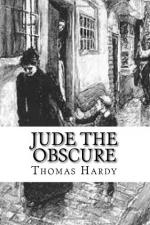|
This section contains 7,845 words (approx. 27 pages at 300 words per page) |

|
SOURCE: Hardy's "Seeming or Personal Impressions: The Use of Image and Contrast in Jude the Obscure", in Modern Fiction Studies, Vol. 6, No. 1, 1960, pp. 233-50.
In the following essay, McDowell explores the symbolism of Jude the Obscure, contending that the novel's images "parallel events and deepen realistic and psychological aspects of the narrative" and afford the work a "richer texture" and greater depth of meaning.
I
Sixty years after publication, Thomas Hardy's Jude the Obscure still elicits controversial judgments. The majority of recent critics, such as William R. Rutland, Lord David Cecil, R. A. Scott-James, Douglas Brown, and Evelyn Hardy, have judged the book a relative failure because of its violations of probability, its morbidity, or its philosophical pretentiousness.1 Other critics, such as Lascelles Abercrombie, H. C. Duffin, Joseph Warren Beach, Arthur McDowall, and Albert Guerard, have acclaimed the book as possibly Hardy's best.2 I agree with the most...
|
This section contains 7,845 words (approx. 27 pages at 300 words per page) |

|


